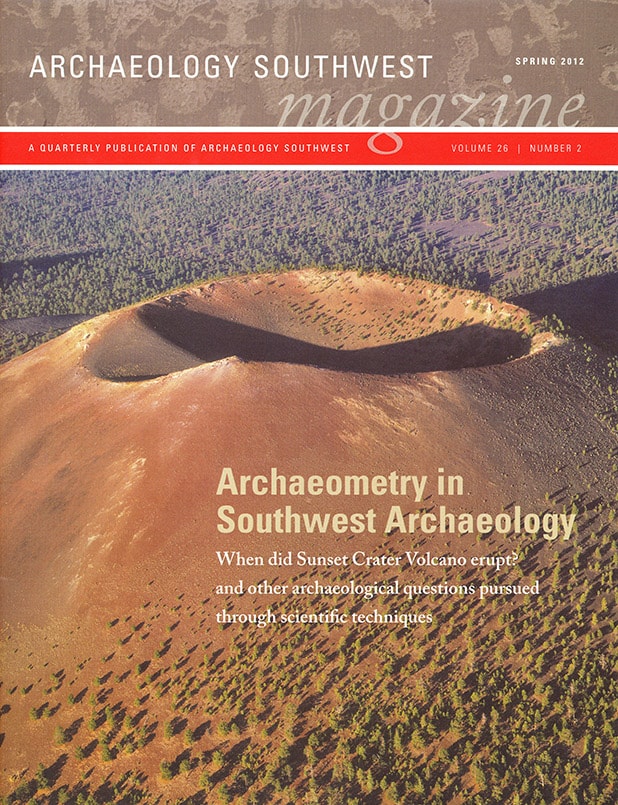Archaeometry in Southwest Archaeology
Archaeology Southwest Magazine Vol. 26, No. 2
Free PDF Download
Issue editors: Mary F. Ownby and Mark D. Elson, Desert Archaeology, Inc.
Cover image: Sunset Crater Volcano by Adriel Heisey.
Archaeology is unique among the social sciences in its considerable adoption of techniques developed in the physical sciences. Through archaeometry—the integration of science and anthropological theory—we have gained a richer understanding of the past.
To download a glossary of scientific terms and techniques featured or mentioned in this issue (PDF), click here.
ONLINE EXCLUSIVE ESSAY: Portable X-ray Fluorescence Spectrometry (pXRF): The Good, the Bad, and the Ugly — M. Steven Shackley, Geoarchaeological XRF Laboratory (opens as a PDF)
ONLINE EXCLUSIVE ESSAY: The Use of Portable X-ray Fluorescence Spectrometry for Analyzing Ancient Ceramics — Mary F. Ownby, Desert Archaeology, Inc. (opens as a PDF)
Archaeometry in Southwest Archaeology: Pursuing Archaeological Questions through Scientific Techniques — Mary F. Ownby and Mark D. Elson, Desert Archaeology, Inc.
Glossary of scientific terms and techniques featured or mentioned in this issue (opens as a PDF)
Official website of the Laboratory of Tree-ring Research, University of Arizona
Archaeology and Archaeometry at the National Science Foundation
When Did It Happen? (Re)Dating the Eruption of Sunset Crater Volcano — Mark D. Elson, Desert Archaeology, Inc., and Michael H. Ort, Northern Arizona University
Archaeology Southwest Magazine Vol. 17, No. 1 (opens as a PDF) — In the Shadow of the Volcano: Recent Research at Sunset Crater
Official website of Sunset Crater Volcano National Monument
Official website of Wupatki National Monument
What Is It Made Of? Scanning Electron Microscopy of Minuscule Beads — Mary F. Ownby and Jenny L. Adams, Desert Archaeology, Inc.
Where Was It Made? Using Petrography to Reconstruct Trade in Eastern Sonora — Matthew Pailes, University of Arizona
More about ceramic petrography
Where Did It Come From? Source Analysis of Obsidian Found at the Yuma Wash Site — Stacy L. Ryan, Desert Archaeology, Inc., and M. Steven Shackley, University of California, Berkeley
Website of Dr. Shackley’s Geoarchaeological XRF Lab
Special: Portable XRF Analysis of a Special Collection from Los Morteros — Stacy L. Ryan, Desert Archaeology, Inc., and M. Steven Shackley, University of California, Berkeley
ONLINE EXCLUSIVE ESSAY: Portable X-ray Fluorescence Spectrometry (pXRF): The Good, the Bad, and the Ugly — M. Steven Shackley, Geoarchaeological XRF Laboratory (opens as a PDF)
ONLINE EXCLUSIVE ESSAY: The Use of Portable X-ray Fluorescence Spectrometry for Analyzing Ancient Ceramics — Mary F. Ownby, Desert Archaeology, Inc. (opens as a PDF)
Where Did It Come From? Using X-ray Diffraction to Track Argillite Sources and Artifacts — Mark D. Elson, Desert Archaeology, Inc.
For a formal report of this research, see:
Elson, Mark D. and James N. Gundersen
1992 The Mineralogy and Sourcing of Argillite Artifacts: A Preliminary Examination of Procurement, Production, and Distribution Systems. In Elson and Craig, The Rye Creek Project: Archaeology in the Upper Tonto Basin, Volume 2, Center for Desert Archaeology Anthropological Papers No. 11, pp. 429–462.
Where Did It Come From? A New Method for Learning about Ancient Turquoise Mining and Trade — Alyson Marie Thibodeau, University of Arizona
This study is described in detail in the forthcoming paper:
Thibodeau, A. M., J. T. Chesley, J. Ruiz, D. J. Killick, and A. Vokes
An Alternative Approach to the Prehispanic Turquoise Trade. In Turquoise in Mexico and North America: Science, Conservation, Culture, and Collections, edited by J. C. H. King, C. R. Cartwright, R. Stacey, C. McEwan, and M. Carocci. Archetype, London.
Where Was It Grown? Biogeochemical Markers and Chaco’s Corn — Linda S. Cordell, University of Colorado Boulder and School for Advanced Research
Official website of Chaco Culture National Historical Park
Website of Crow Canyon Archaeological Center (Cortez, CO)
For more on this research, see:
Cordell, Linda S., H. Wolcott Toll, Mollie S. Toll, and Thomas C. Windes
2008 Archaeological Corn from Pueblo Bonito, Chaco Canyon, New Mexico: Dates, Contexts, Sources. American Antiquity 73(3):491–511.
(and references therein)
Why Did They Do That? Soil Science and Ancient Agriculture on Perry Mesa — Melissa Kruse-Peeples, Arizona State University and Native Seeds/SEARCH
Project website—includes a PDF of a poster explaining this research
Back Sight — William H. Doelle, Archaeology Southwest
Subscribe
